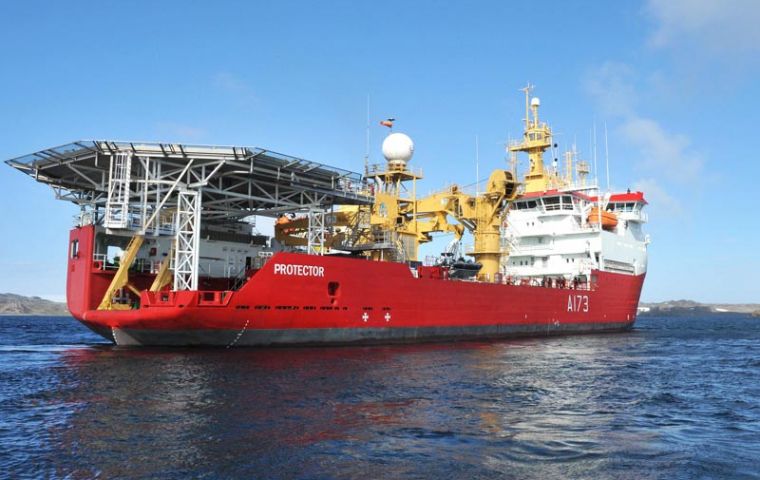MercoPress. South Atlantic News Agency
HMS Protector on route to the Antarctic previous surveying in St Helena
 The Ice Patrol during her last foray in Antarctica
The Ice Patrol during her last foray in Antarctica The Royal Navy’s Ice Patrol ship HMS Protector is on her way for an eight-month deployment surveying and patrolling Antarctica. She left Portsmouth late September and is currently visiting St Helena to conduct surveys of the harbour in preparation for the building of a new jetty.
HMS Protector is scheduled to call in the Falkland Islands and will arrive in Antarctica for the austral summer and has plans to make four forays into the ice. During this time she will utilize her multi beam echo sounder and deploy her survey motor boat to ensure the UK provides cutting-edge, hydrographic imagery of the Antarctic region.
Around 80% of the world’s charts are provided by the Royal Navy’s hydrographic department.
The ship will also assist with the re-supply of British Antarctic Survey stations in the region.
Protector’s Commanding Officer, Captain Peter Sparkes, said: “Building upon the success - and the lessons identified - from HMS Protector’s inaugural deployment to Antarctica, the ship and her company is ready in all respects to face again the challenges of the southern ocean. HMS Protector exemplifies the Royal Navy’s global reach and the UK government’s commitment to British interests in the South Atlantic.”
The 5.000 ton ice patrol is equipped with a flotilla of small boats, including: the state-of-the-art survey motor boat, ‘James Caird IV’; a. 8.5m ramped Work Boat, ‘Terra Nova’, and; two Pacific 22 rigid inflatable boats (‘Aurora and ‘Nimrod’). Three BV206 all-terrain vehicles and four quad bikes, complete with trailers, will also be carried and craned directly onto the ice to assist with the re-supply of British Antarctic Survey scientific stations.
HMS Protector has a historic connection with Britain's Antarctic commitment: it was the name of the ship, which preceded the former Endurance (1968-91) in the South Atlantic role.
She will carry out all the functions of an Antarctic patrol ship such as deployed to patrol and survey the Antarctic and South Atlantic, maintaining a UK presence and supporting the international community in the region. This involves close links with the Foreign and Commonwealth Office, the UK Hydrographic Office and the British Antarctic Survey.




Top Comments
Disclaimer & comment rules-

-

-

Read all commentsAny comment about laying mines is pretty hypocritical considering that there are still minefields on the islands from '82 still awaiting clearance which were laid by your country - oh sorry - it was that nasty junta so it's not your fault.
Oct 05th, 2012 - 10:35 pm +1The BAS is a scientific organisation. It is as simple as that.
lol, UK doesn't have to “spy”. They openly pass through those waters as they please, and survey their territory as they please, while you turn red in the face Argies.
Oct 05th, 2012 - 11:34 pm +1The Brits did not use mines in 82. Argentina did, thankfully they did not have many. Those they did have were deployed around Port stanley, wrong again! You know what the Brits did prior to the landings at San Carlos? They sent a frigate up the sound to see if it was mined! not very technical, hey!
Oct 06th, 2012 - 12:51 am +1Commenting for this story is now closed.
If you have a Facebook account, become a fan and comment on our Facebook Page!